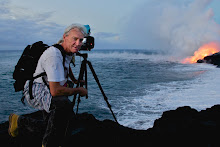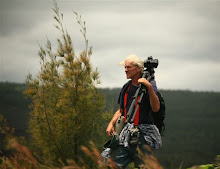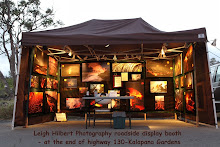 The aerial photo above taken by the United States Geological Survey (USGS) on January 7th, 2010 looks down upon the Waikupanaha coastline and reveals the amount of active ocean entry lava to be seen there this past week: none; by far the longest cessation in the twenty months it has been flowing there.
The aerial photo above taken by the United States Geological Survey (USGS) on January 7th, 2010 looks down upon the Waikupanaha coastline and reveals the amount of active ocean entry lava to be seen there this past week: none; by far the longest cessation in the twenty months it has been flowing there.The photo below is one I posted two months ago on November 7th, 2009 depicting the relationship of important features on the coastal active lava fields and the Waikupanaha, and shows a normally robust steam & ash plume.
 (Click on any photo for a larger size)
(Click on any photo for a larger size)When will molten lava return to the surface and ocean entry areas?
No one knows.
 But by looking at this mornings deformation map of magma pressures beneath the Kilauea Volcano, they have flat-lined, or even tweaked lower; much lower than ever recorded since the Waikupanaha lava flow 1st entered the ocean here on March 5th, 2008. Therefore it is very unlikely any resurgence of magma/lava pressure, even if it starts inflating now, will activate molten lava production that can be visually enjoyed in the next twenty-four hours.
But by looking at this mornings deformation map of magma pressures beneath the Kilauea Volcano, they have flat-lined, or even tweaked lower; much lower than ever recorded since the Waikupanaha lava flow 1st entered the ocean here on March 5th, 2008. Therefore it is very unlikely any resurgence of magma/lava pressure, even if it starts inflating now, will activate molten lava production that can be visually enjoyed in the next twenty-four hours. Here is a simplified illustration of the magma under Kilauea:
 Magma pathways beneath Kilauea Volcano
Magma pathways beneath Kilauea VolcanoUSGS: “Magma rising into Kilauea Volcano first enters a principal storage reservoir beneath its summit caldera. The magma may then erupt at the summit or move through one of two principle pathways (rift zones) beneath the flanks of Kilauea (arrows show direction). This movement of magma down the rift zones causes the summit area to subside, which is recorded by tiltmeters as an inward tilt of the caldera rim. When magma is not moving down one of the rift zones, the summit caldera inflates slowly as shown by an increase in ground tilt, indicating magma is rising into the summit reservoir.”
And a simplified map of the #1 Rift Zone: (My home sits exactly on the center of the east end of this zone; geothermal steam vents on my property)











No comments:
Post a Comment